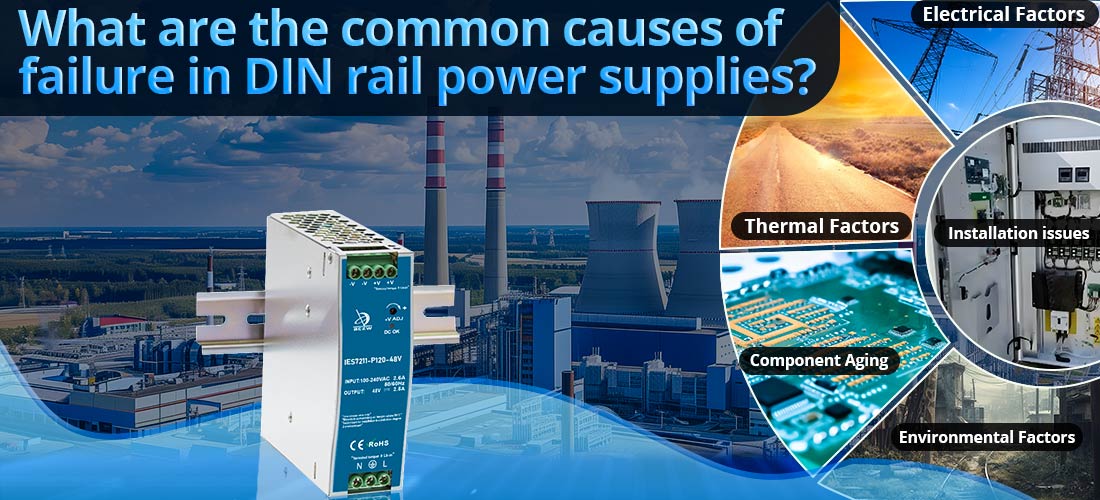
Las causas comunes de fallas en las fuentes de alimentación de riel DIN se pueden atribuir a varios factores, incluidas las condiciones ambientales, tensión eléctrica, instalación deficiente o problemas con los componentes internos. Identificar estas causas es esencial para garantizar la confiabilidad y extender la vida útil de la fuente de alimentación. A continuación se muestra una descripción detallada de los motivos más frecuentes por los que fallan las fuentes de alimentación de carril DIN.
1. Factores eléctricos
1.1. Sobretensión
--- Causa: picos repentinos de voltaje o sobretensiones de la línea de alimentación de entrada, a menudo causados por rayos, operaciones de conmutación o fallas en la red eléctrica.
--- Efecto: La sobretensión puede dañar componentes internos sensibles como condensadores, semiconductores y diodos.
1.2. Sobrecarga
--- Causa: Conexión de cargas que exceden la capacidad nominal de la fuente de alimentación.
--- Efecto: La sobrecarga continua provoca una acumulación excesiva de calor, lo que reduce la eficiencia y la vida útil de componentes como transformadores y MOSFET.
1.3. Cortocircuitos
--- Causa: Fallos en los dispositivos conectados o errores de cableado pueden provocar cortocircuitos en los terminales de salida.
--- Efecto: Los cortocircuitos repetidos pueden dañar los circuitos de protección de la fuente de alimentación o los componentes de salida.
1.4. Armónicos y Ruido Eléctrico
--- Causa: Las cargas no lineales y el ruido de alta frecuencia en el sistema de energía pueden crear tensión en el rectificador de entrada y las etapas de filtrado.
--- Efecto: Degradación de los componentes debido a tensiones adicionales.
2. Factores térmicos
2.1. Calentamiento excesivo
--- Causa: Ventilación inadecuada, funcionamiento en ambientes de alta temperatura o sobrecarga de la fuente de alimentación.
--- Efecto: El sobrecalentamiento acelera el envejecimiento de los componentes internos, especialmente los condensadores y transformadores electrolíticos, lo que provoca fallos prematuros.
2.2. Mala disipación de calor
--- Causa: Acumulación de polvo, flujo de aire bloqueado o posiciones de montaje inadecuadas que dificultan el enfriamiento.
--- Efecto: El aumento de la temperatura interna puede provocar paradas térmicas o daños permanentes.
3. Factores ambientales
3.1. Humedad y Humedad
--- Causa: Exposición a condiciones de humedad, condensación o contacto directo con agua.
--- Efecto: Corrosión de conectores, PCB y terminales, lo que provoca cortocircuitos eléctricos o reducción del rendimiento.
3.2. Vibración y choque
--- Causa: Operar en entornos con maquinaria pesada o sistemas de transporte donde se producen vibraciones constantes o golpes físicos.
--- Efecto: Aflojamiento de conexiones internas, grietas en las juntas de soldadura o daños físicos a los componentes.
3.3. Polvo y contaminantes
--- Causa: Uso en ambientes polvorientos o sucios sin recintos adecuados.
--- Efecto: La acumulación de polvo puede aislar los componentes que generan calor o provocar cortocircuitos.
4. Envejecimiento de los componentes
4.1. Degradación del condensador
--- Causa: Los condensadores electrolíticos se degradan naturalmente con el tiempo, especialmente en condiciones de alta temperatura o alto estrés.
--- Efecto: La capacidad de filtrado reducida conduce a un aumento del voltaje de ondulación y a una eventual falla.
4.2. Desgaste de semiconductores
--- Causa: Funcionamiento prolongado a altas temperaturas o exposición repetida a sobretensiones.
--- Efecto: Reducción del rendimiento o avería de diodos, MOSFET y transistores.
4.3. Desglose del aislamiento del transformador
--- Causa: Envejecimiento o exposición a calor y humedad excesivos.
--- Efecto: Pérdida de aislamiento eléctrico y posible falla del proceso de conversión de energía.
5. Problemas de instalación y mantenimiento
5.1. Montaje inadecuado
--- Causa: Orientación incorrecta o espacio insuficiente entre dispositivos adyacentes en el riel DIN.
--- Efecto: Flujo de aire restringido y aumento de la acumulación de calor, lo que provoca problemas térmicos.
5.2. Conexiones sueltas
--- Causa: Terminales de entrada o salida mal apretados.
--- Efecto: funcionamiento intermitente, formación de arcos y daños en los puntos de conexión.
5.3. Falta de mantenimiento preventivo
--- Causa: No limpiar, inspeccionar o reemplazar componentes viejos.
--- Efecto: Mayor probabilidad de fallas repentinas debido a desgaste o daño no detectado.
6. Defectos de diseño y fabricación
6.1. Componentes de baja calidad
--- Causa: Uso de componentes de calidad inferior en el proceso de fabricación para reducir costes.
--- Efecto: Mayor susceptibilidad a fallos en condiciones normales de funcionamiento.
6.2. Pruebas insuficientes
--- Causa: Falta de pruebas rigurosas durante la producción.
--- Efecto: Las unidades con defectos ocultos pueden fallar prematuramente en el campo.
6.3. Diseño de circuito deficiente
--- Causa: Diseño ineficiente que conduce a una disipación de calor inadecuada, circuitos de protección insuficientes o una dependencia excesiva de componentes específicos.
--- Efecto: Reducción de la confiabilidad general y mayores tasas de falla.
7. Señales de fracaso inminente
--- Voltaje de salida inestable: Fluctuaciones, ondulaciones o caídas de voltaje bajo carga.
--- Ruidos inusuales: zumbidos, zumbidos o chasquidos que indican tensión en los componentes internos.
--- Calor excesivo: Sobrecalentamiento de la carcasa o componentes externos.
--- Olor a quemado: Indica sobrecalentamiento o daño eléctrico.
--- Paradas Frecuentes: Activación de protección por sobretemperatura o sobrecorriente.
8. Medidas preventivas
--- Asegure una ventilación adecuada: mantenga un espacio suficiente y limpie las rutas de flujo de aire.
--- Supervise las condiciones de funcionamiento: utilice la fuente de alimentación dentro de sus límites nominales de temperatura, carga y voltaje.
--- Utilice dispositivos de protección: instale protectores contra sobretensiones, filtros EMI y fusibles adecuados.
--- Realice un mantenimiento regular: limpie e inspeccione las conexiones, elimine el polvo y compruebe si hay signos de desgaste.
--- Seleccione unidades de alta calidad: use Fuentes de alimentación en carril DIN con certificaciones y registros de confiabilidad.
Conclusión
Las fuentes de alimentación de riel DIN fallan debido a una combinación de problemas eléctricos, térmicos, ambientales, relacionados con los componentes y de instalación. Comprender estas causas e implementar medidas preventivas puede mejorar significativamente la confiabilidad y la vida útil del suministro de energía. La selección adecuada, el mantenimiento regular y el monitoreo de las condiciones operativas son clave para minimizar las fallas.